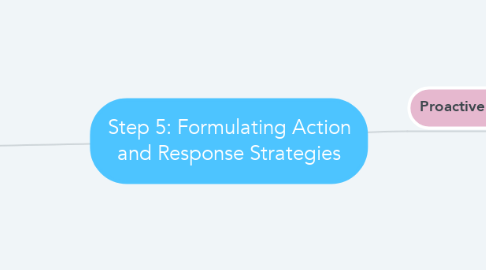
1. Proactive Strategy
1.1. Action
1.1.1. Can be most effective because they are proactive. They are implemented according to the planning of the organisation, rather than by a need to respond to outside pressure and expectations from publics.
1.1.1.1. Organisation Performance
1.1.1.1.1. The performance of an organisation is what it does to ensure the level of quality that meets the wants, needs, interests and expectations of key publics rather than what it says.
1.1.1.1.2. Adaptation: the willingness and ability of the organisation to make changes necessary to create harmony between itself and key publics
1.1.1.2. Audience Engagement
1.1.1.2.1. Audience interest
1.1.1.2.2. Audience participation
1.1.1.2.3. Audience feedback
1.1.1.2.4. Triggering event
1.1.1.3. Special Events (Staged activity)
1.1.1.3.1. an activity that an organisation develops or orchestrates to gain attention and acceptance of key publics. needs to be legitimate. designed primarily as a means of engaging public and encouraging interaction with org, potential for media attention is secondary
1.1.1.3.2. Publicity stunt: opp from special event. gimmick planned mainly to gain publicity. avoid this!
1.1.1.4. Alliances & Coalitions
1.1.1.4.1. when 2 or more organisations work together to produce an outcome that is greater than the input of each group separately. seek to forge relationships
1.1.1.5. Sponsorships
1.1.1.5.1. providing a program directly or providing financial, personnel, or other resources the program requires
1.1.1.5.2. make sure there is a logical link between activity being sponsored and purpose/ mission of your org
1.1.1.6. Strategic Philanthropy
1.1.1.6.1. businesses fund or support community relations gestures with an eye toward enhancing their own business interests as well as interests of their employees and customers
1.1.1.7. CSR
1.1.1.7.1. Doing good – based on mission and vision of organization
1.1.1.7.2. Should be based on business model/ decision rather than an emotional one
1.1.1.8. Volunteerism
1.1.1.8.1. Corporate policy of encouraging, facilitating employees in projects that contribute to better quality of life in a community.
1.1.1.8.2. Employee volunteering as a form of engaging with strategic philanthropy and the benefits it brings back to the organisation
1.1.1.9. Activism
1.1.1.9.1. Non-profit organisations to present their messages and enhance their relationship with key publics especially members, donors and sympathisers.
1.2. Communication
1.2.1. Enables organisation to launch communication program under the conditions and according to timelines that seem to best fit the organisation's interests.
1.2.1.1. Publicity
1.2.1.1.1. attention given by news media to an organisation, person, event, product or idea
1.2.1.1.2. High credibility with audiences due to the effect of third party endorsement gained through media gatekeepers such as reporters, editors and influential bloggers
1.2.1.2. Newsworthy Information
1.2.1.2.1. One of the strongest proactive strategies whereby the organization generates news that is of interest to key publics and attracts the attention of the media
1.2.1.3. Generating News
1.2.1.3.1. present newsworthy information with a visual dimension
1.2.1.3.2. If news is not newsworthy, can always create newsworthy activity for organisation eg give award, hold contest, comment on local prob/ need, launch campaign, involve celebrity
1.2.1.4. News Peg
1.2.1.4.1. Media report relating to organization – (related to media, publics, and the organization)
1.2.1.5. Transparent Communication
1.2.1.5.1. The strategy of transparent communication deals with openness, and increasing knowledge and understanding among key publics.
2. Reactive Strategy
2.1. Pre-emptive Action
2.1.1. A pre-emptive strike that is launched before the crisis actually hits
2.1.1.1. Prebuttal
2.1.1.1.1. speakers raise objections to their own arguments so they can refute the opposing viewpoint
2.2. Offensive Response
2.2.1. Organisation comes from a position of strength
2.2.1.1. Attack
2.2.1.1.1. Gross overstatement of the organization’s involvement in a problem or that they have been negligent or malicious in their accusation
2.2.1.2. Embarrassment
2.2.1.2.1. organisation tries to lessen opponent's influence by using shame/ humiliation
2.2.1.3. Shock
2.2.1.3.1. Deliberate agitation of the mind or emotions
2.2.1.4. Threat
2.2.1.4.1. Lawsuits for defamation
2.2.1.5. Standing firm
2.2.1.5.1. To reiterate its action or position, allowing whatever consequences to occur
2.3. Defensive Response
2.3.1. Organization reacting less to aggressive criticism
2.3.1.1. Denial
2.3.1.1.1. Refutation, proclamation of innocence, mistaken identity or blame shifting
2.3.1.2. Excuse
2.3.1.2.1. Minimise responsibility. Types: provocation, lack of control accident, victimisation and association
2.3.1.3. Justification
2.3.1.3.1. A good reason. Types: good intention, context, idealism and mitigation
2.3.1.4. Reversal
2.3.1.4.1. Change in fortunes
2.4. Diversion Response
2.4.1. To shift gaze of the publics from the problems related to the organization.
2.4.1.1. Concession
2.4.1.1.1. giving the public something it wants
2.4.1.2. Ingratiation
2.4.1.2.1. similar to concession but not a gift of real significance to the organization or to the adversaries
2.4.1.3. Disassociation
2.4.1.3.1. attempt to distance an organization from the accusation/problem
2.4.1.4. Relabeling
2.4.1.4.1. the strategy of replacing a tarnished/ negative/disreputable label with a more neutral/ positive label
2.5. Vocal Commiseration
2.5.1. organisation expresses empathy and understanding about the misfortune suffered by its publics
2.5.1.1. Concern
2.5.1.1.1. Expresses that the organization is not indifferent to a problem without admitting guilt
2.5.1.2. Condolence
2.5.1.2.1. expresses grief without admitting guilt
2.5.1.3. Regret
2.5.1.3.1. expresses sorrow and remorse, with or without admitting guilt
2.5.1.4. Apology
2.5.1.4.1. accepts full responsibility and asks for forgiveness
2.6. Rectifying Behaviour
2.6.1. organisation does something to repair the damage done to its publics
2.6.1.1. Investigation
2.6.1.1.1. Examine the situation and revert
2.6.1.2. Corrective action
2.6.1.2.1. Contain the problem, repair the damage and to prevent recurrence
2.6.1.3. Resitution
2.6.1.3.1. Making amends by compensating the victims/restoring a situation to its earlier condition
2.6.1.4. Repentance
2.6.1.4.1. Involves both change of heart and change in action
2.7. Deliberate Inaction
2.7.1. done by an organisation under siege to offer no substantive comment
2.7.1.1. Strategic silence
2.7.1.1.1. Not responding to the situation. Different from no comment. quietly take some action
2.7.1.2. Strategic ambiguity
2.7.1.2.1. Artful dodging of a question, ambiguity and obfuscation
2.7.1.3. Strategic inaction
2.7.1.3.1. Say nothing-do nothing strategy; wait it out and hope that the situation fades away

